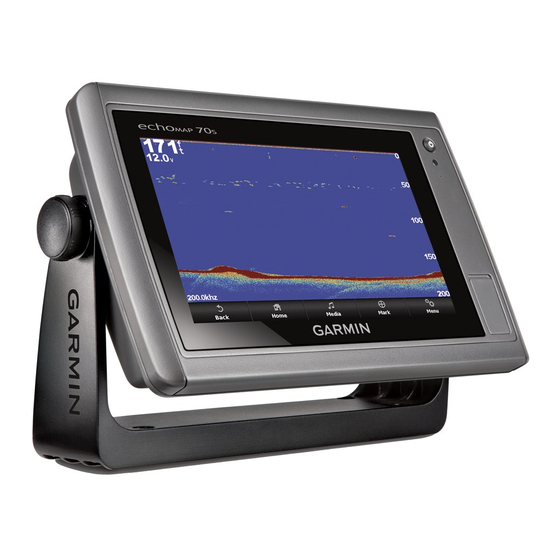2
If necessary, select Chart Setup.
3
Select Overlay Numbers > Edit Layout.
4
Select a layout.
5
Select a data field.
6
Select the type of data shown in the field.
Available data options vary based on the chartplotter and
network configuration.
Showing a Navigation Inset
You can control whether a navigation inset appears on some
chart views. The navigation inset is shown only when the boat is
navigating to a destination.
1
From a chart or 3D chart view, select MENU.
2
If necessary, select Chart Setup.
3
Select Overlay Numbers > Nav. Inset > Auto.
4
Select Navigation Inset Setup.
5
Complete an action:
• To show waypoint velocity made good (VMG) when
navigating a route with more than one leg, select Route
Leg Details > On.
• To show next-turn data based on distance, select Next
Turn > Distance.
• To show next-turn data based on time, select Next Turn >
Time.
• To indicate how the destination data appears, select
Destination, and select an option.
Chart Appearance Settings
You can adjust the appearance of the different chart views.
Each setting is specific for the type of chart view that you are in.
NOTE: Not all settings apply to all charts and 3D chart views
and chartplotter models. Some options require premium maps
or connected accessories, such as radar.
From a chart or 3D chart view, select MENU > Chart Setup >
Chart Appearance.
Orientation: Sets the perspective of the map.
Detail: Adjusts the amount of detail shown on the map, at
different zoom levels.
Heading Line: Shows and adjusts the heading line, which is a
line drawn on the map from the bow of the boat in the
direction of travel, and sets the data source for the heading
line.
World Map: Uses either a basic world map or a shaded relief
map on the chart. These differences are visible only when
zoomed out too far to see the detailed charts.
Spot Depths: Turns on spot soundings and sets a dangerous
depth. Spot depths that are equal to or more shallow than
the dangerous depth are indicated by red text.
Safety Shading: Sets the shades from the shoreline to the
specified depth.
Depth Range Shading: Specifies an upper and lower depth to
shade between.
Symbols: Shows and configures the appearance of various
symbols on the chart, such as the vessel icon, navaid
symbols, land POIs, and light sectors.
Inset Map: Shows a map zoomed in on the vessel's location in
the corner of the main map.
Style: Sets how the chart appears over 3D terrain.
Hazard Colors: Shows shallow water and land with a color
scale. Blue indicates deep water, yellow is shallow water,
and red is very shallow water.
Safe Depth: Sets the appearance of a safe depth for Mariner's
Eye 3D.
Navigation with a Chartplotter
NOTE: This setting affects only the appearance of hazard
colors in Mariner's Eye 3D. It does not affect the safe water
depth Auto Guidance setting or the sonar shallow water
alarm setting.
Range Rings: Shows and configures the appearance of range
rings, which help you to visualize distances in some chart
views.
Lane Width: Specifies the width of the navigation lane, which is
the magenta line in some chart views that indicates the
course to your destination.
Fish Eye 3D Settings
NOTE: This feature is available with premium charts, in some
areas.
From the Fish Eye 3D chart view, select MENU.
View: Sets the perspective of the 3D chart view.
Tracks: Shows tracks.
Sonar Cone: Shows a cone that indicates the area covered by
the transducer.
Fish Symbols: Shows suspended targets.
Navigation with a Chartplotter
If your vessel has an autopilot system, a dedicated autopilot
control display must be installed at each steering helm in order
to disable the autopilot system.
The Auto Guidance feature is based on electronic chart
information. That data does not ensure obstacle and bottom
clearance. Carefully compare the course to all visual sightings,
and avoid any land, shallow water, or other obstacles that may
be in your path.
NOTE: Auto Guidance is available with premium charts, in
some areas.
NOTE: Mariner's Eye 3D and Fish Eye 3D chart views are
available with premium charts, in some areas.
NOTE: The offshore Fishing chart is available with premium
charts, in some areas.
To navigate, you must choose a destination, set a course or
create a route, and follow the course or route. You can follow
the course or the route on the Navigation chart, Fishing chart,
Perspective 3D chart view, or Mariner's Eye 3D chart view.
Basic Navigation Questions
Question
How do I make the chartplotter
point me in the direction in
which I want to go (bearing)?
How do I make the device
guide me along a straight line
(minimizing cross track) to a
location using the shortest
distance from the present
location?
How do I make the device
guide me to a location while
avoiding charted obstacles?
How do I make the device
steer my automatic pilot?
CAUTION
Answer
Navigate using Go To. See
Setting
and Following a Direct Course Using
Go
To.
Build a single-leg route and navigate it
using Route To. See
Creating and
Navigating a Route From Your
Present
Location.
Build a multi-leg route and navigate it
using Route To. See
Creating and
Navigating a Route From Your
Present
Location.
Navigate using Route To. See
Creating and Navigating a Route From
Your Present
Location.
7

